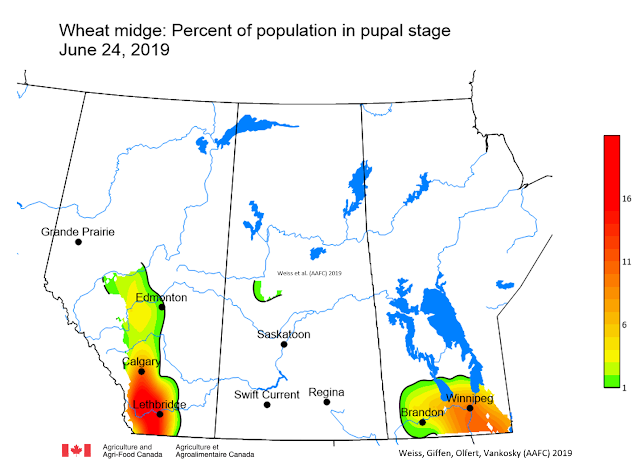Wheat midge adults generally emerge during the first week of July. Compared to long term normal values for temperature and rainfall, May and June in the Saskatoon region has been approximately 1 °C cooler and rainfall is 40-60% less than normal. Dry conditions in May and June can have significant impact on wheat midge emergence. Insufficient rainfall in May and June can result in delayed movement of larvae to the soil surface. Elliott et al (2009) reported that wheat midge emergence was delayed or erratic if rainfall did not exceed 20-30 mm during May. Olfert et al. 2016 ran model simulations to demonstrate how rainfall impacts wheat midge population density. Our wheat midge model indicates that dry conditions may result in:
a. Delayed adult emergence and oviposition
b. Reduced numbers of adults and eggs
The wheat midge model indicates that 70% (82% last week) of the population are in the larval cocoon stage and 29% (18% last week) of the population is predicted to have moved to the soil surface. The first map presents wheat midge development as of last week (Fig. 1).
 |
| Figure 1. Percent of larval population at the soil surface (as of June 17, 2019) across the Canadian prairies. |
 |
| Figure 2. Percent of larval population at the soil surface (as of June 24, 2019) across the Canadian prairies. |
 |
| Figure 3. Percent of population AT PUPAL STAGE (as of June 24, 2019) across the Canadian prairies. |
Monitoring:
When monitoring wheat fields, pay attention to the synchrony between flying midge and anthesis.
In-field monitoring for wheat midge should be carried out in the evening (preferably after 8:30 pm or later) when the female midges are most active. On warm (at least 15ºC), calm evenings, the midge can be observed in the field, laying their eggs on the wheat heads (photographed by AAFC-Beav-S. Dufton & A. Jorgensen below). Midge populations can be estimated by counting the number of adults present on 4 or 5 wheat heads. Inspect the field daily in at least 3 or 4 locations during the evening.
REMEMBER that in-field counts of wheat midge per head remain the basis of economic threshold decision. Also remember that the parasitoid, Macroglenes penetrans (photographed by AAFC-Beav-S. Dufton below), is actively searching for wheat midge at the same time. Preserve this parasitoid whenever possible and remember your insecticide control options for wheat midge also kill these beneficial insects which help reduce midge populations.
Economic Thresholds for Wheat Midge:
a) To maintain optimum grade: 1 adult midge per 8 to 10 wheat heads during the susceptible stage.
b) For yield only: 1 adult midge per 4 to 5 heads. At this level of infestation, wheat yields will be reduced by approximately 15% if the midge is not controlled.
Inspect the developing kernels for the presence of larvae and the larval damage.
NEW - Alberta Agriculture and Forestry has also released a YouTube video describing in-field monitoring for wheat midge this week.
More information about Wheat midge can be found by accessing the pages from the new "Field Crop and Forage Pests and their Natural Enemies in Western Canada: Identification and Field Guide". View ONLY the Wheat midge pages but remember the guide is available as a free downloadable document as both an English-enhanced or French-enhanced version.

